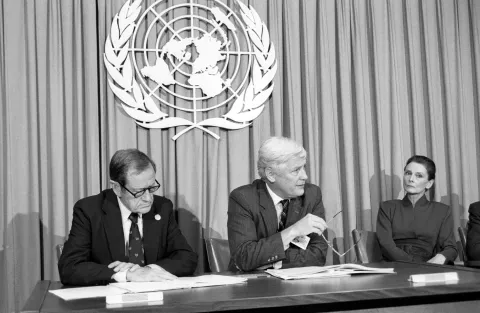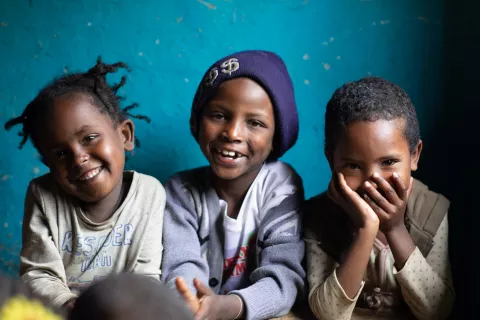Emerging from the ashes of war: 1946–1979
From the smoke and ashes of World War II, a refugee crisis emerged unlike any the world had seen. Out of this destruction, UNICEF was created to ease the burden of the world’s most vulnerable children., 1946, The International Children’s Emergency Fund (ICEF) is created by the UN Relief Rehabilitation Administration to help children affected by World War II. ICEF is for child health purposes generally and aid is to be distributed to all children, without discrimination. On 11 December 1946, a resolution of the United Nations General Assembly brings…, 1947 to 1965, During his 18 years as Executive Director, Maurice Pate expanded UNICEF’s work to meet the needs of children in a more holistic way. He also strengthened consensus that the needs of children surpass politics. “There are no enemy children.” Maurice Pate, UNICEF Executive Director (1947–1965). UNICEF Executive director Maurice Pate sits with…, 1947, The first private contribution to UNICEF is received. To this day, UNICEF relies on millions of supporters to help to make a difference in the lives of children. In the same year, the first UNICEF National Committee is established in the United States. National Committees are a supportive network of independent charities that raise funds to…, 1949, The first UNICEF greeting card is issued. Selling UNICEF cards soon became one of the organization’s largest and most enduring fundraising activities. UNICEF National Committees will play a key role in the sale of billions of cards during the next seven decades. Drawing of dancing children by seven-year-old Dzitka Samkova. United States, 1949:…, 1950, Due to the “necessity for continued action to relieve the sufferings of children” the United Nations General Assembly extends UNICEF’s mandate ─ emphasizing the organization’s support for children outside of Europe. A student in Suwon, Repluc of Korea, prepares to drink her daily ration of milk. Republic of Korea, 1950: A student in Suwon prepares…, 1953, UNICEF becomes a permanent United Nations agency. The words ‘International’ and ‘Emergency’ are dropped from the official name but the acronym is retained. UNICEF’s projects in water, sanitation and hygiene seek to reduce preventable childhood diseases and death. Campaigns to eradicate yaws, leprosy and trachoma are highly effective. A health…, 1954, Beloved United States entertainer Danny Kaye becomes UNICEF’s "Ambassador at Large". Danny Kaye visits his former primary school in Brooklyn, New York. United States, 1954: Danny Kaye visits his former primary school in Brooklyn, New York, where he encourages students to help raise funds for UNICEF., 1956, Between 1956 and 1957, more than 13,000 maternal and child welfare centres receive UNICEF supplies and technical training in 102 countries. A child is tested for tuberculosis. The Philippines, 1956: A mobile vaccination team in Batangas tests children for tuberculosis., 1957, UNICEF launches new nutrition programmes. Communities are trained in vegetable gardening, fish pond management, poultry and livestock breeding, and receive education about nutrition. A boy feeds his family’s chickens. Thailand, 1955. Thailand, 1995: A boy feeds his family’s chickens., 1959, The United Nations Declaration of the Rights of the Child defines children’s rights to protection, education, healthcare, shelter and good nutrition. A doctor tests children for tuberculosis in New Delhi, India. India, 1956: A World Health Organization doctor tests children for tuberculosis in New Delhi. Children who test negative for the disease…, 1961, UNICEF expands its focus to include children’s education. Aid for education programmes are launched globally and continue for years to come. Two boys reading in a temporary school in Pakistan. Pakistan, 1988: Boys at a temporary school in a camp for Afghan refugees in Peshawar., 1964, The Bellagio Conference (or The International Round Table on Children and Youth in Development Planning) in Bellagio, Italy focuses on ways to link children's well being to national development plans. Following the Bellagio conference, UNICEF pivots from being a relief fund to an international development agency with technical expertise in all…, 1965, The Nobel Peace Prize is awarded to UNICEF for the "promotion of brotherhood among nations". The Nobel Peace Prize designation recognizes work for children as work for peace. "The welfare of today’s children is inseparably linked with the peace of tomorrow’s world." Henry Labouisse, UNICEF Executive Director (1965–1979). Henry Labouisse receives…, 1967, Amid much controversy, UNICEF aid for family planning is approved. Family planning support is provided within the context of maternal and child health. Twins are delivered in Ankara, Turkey. Turkey, 1973: Twins are delivered in Ankara. UNICEF support included the provision of midwife kits, vitamins, medical equipment and weaning food., 1968, UNICEF provides aid for mothers and children in civil conflicts in Nigeria and Viet Nam, upholding its philosophy of non-political and non-discriminatory aid. Packages are prepared in Ubulu, Nigeria, for distribution in the Biafra region. Nigeria, 1969: Packages are prepared in Ubulu for distribution in the Biafra region. Each package contains…, 1971, The UNICEF Executive Board expands its aid work to include services "benefiting children in urban slums and shantytowns," increasing the organization’s reach and depth over the years. Two children stand in the street. India, 1992: UNICEF works with governments to reduce child homelessness in cities. United Nations agencies mobilize to provide…, 1973, UNICEF expands aid for non-formal education (outside regular schools), particularly for rural children and youth. Boys enter a training centre. Republic of Dahomey (now Benin), 1969: Boys enter a training centre where they receive education in agronomy in addition to traditional academic subjects., 1975, The Mark II water pump is invented, transforming village life. Children collect water at a Mark II handpump. India, 1980: Within 10 years of its development, the Mark II water pump is used in UNICEF water programmes around the world., 1978, The Alma-Ata conference, jointly convened by WHO and UNICEF, focuses world attention on primary healthcare and emphasizes community-based approaches to family health as the keys to achieving an acceptable level of health throughout the world. A girl is vaccinated while sitting in her mother's lap. Turkey, 1985: A child is vaccinated during the…, 1979, Due to its non-political status, UNICEF is able to lead the United Nations and Red Cross in major relief and rehabilitation operations across Kampuchea, now Cambodia. A boy holds a drawing showing the atrocities of the Khmer Rouge regime. Kampuchea (now Cambodia]), 1980: A boy in a camp for people displaced by civil conflict shows one of his…
















